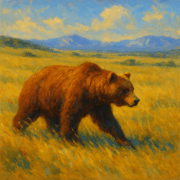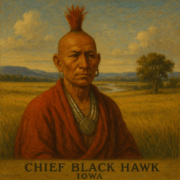If you’ve lived in the Midwest any amount of time, you’ve probably heard the name Black Hawk in some context or other. There are counties named after him, a war named after him. To understand who Black Hawk is, who the people were, and why you hear that name around this Midwest, we have to rewind the clock a little.
Chief Black Hawk belonged to the Sauk Native American tribe, which was closely aligned with the Fox tribe, which is generally known as the Meskwakis. The tail of these tribes is sad and long, a long trail of tears that lasted a few hundred years. That context is essential for understanding Black Hawk and the war that ensued in the Midwest, which gave these people and their namesake, Black Hawk, their place in history.
Pre-1600, these tribes actually lived on the Atlantic coast of the East; for various reasons, including conflict with other tribes and settlers, they ended up around the Saginaw Bay area in Michigan. In the 1640’s with conflict arose and they were forced to move again, this time into Wisconsin.
The Sauk and Fox stayed in Wisconsin up until 1734, when both were forced from across across the Mississippi into what was know as the Iowa Territory at the time (Iowa was not a state at this time).
Even at this time there was a wall of early settlers living in Illinois and Wisconsin, some moving across (illegally into the Iowa Territory). These pioneers knew that their time was coming when they would be able to settle the Indian Territory (Iowa and beyond).
This was a tumultuous time for the Sauk and Fox, like many other tribes they were pushed and pulled around Illinois, Kansas, and modern day Iowa. This is also when they became more widely known, because of the Black Hawk War, and treaties.
“Pressures from white settlement after 1825 forced the Sauk along the Mississippi to leave western Illinois and relocate to southeast Iowa. The exception was Blackhawk’s Band at Rock Island (Illinois) which did not finally leave until after the Blackhawk War in 1832. As a result of the war, the Sauk surrendered a large part of eastern Iowa. The Fox and Sauk remained in Iowa until 1842. “
The Black Hawk War took place primarily in Illinois and Wisconsin and lasted from April to August 1832.
Background
-
In 1804, a disputed treaty led the U.S. to claim land in western Illinois and eastern Iowa that had long been occupied by the Sauk and Fox tribes.
-
Many Sauk, including Black Hawk, rejected the treaty, claiming it was signed without proper tribal consent.
What Triggered the War?
-
In 1832, Black Hawk led about 1,000 people (warriors and families) back across the Mississippi River into Illinois to reclaim ancestral lands — hoping to live there peacefully or possibly align with the British or other tribes.
-
U.S. settlers and officials viewed this as an invasion.
Conflict
-
The Illinois militia and U.S. Army pursued Black Hawk’s band, resulting in several skirmishes and massacres.
-
Native American resistance was largely unorganized compared to the U.S. forces.
-
Major engagements included the Battle of Stillman’s Run, the Wisconsin Heights, and the final Battle of Bad Axe, where most of Black Hawk’s followers were killed or captured.
Aftermath
-
Black Hawk was captured and imprisoned, later taken on a tour of Eastern U.S. cities before being released.
-
The war marked the end of Native armed resistance in the Old Northwest (modern-day Midwest).
-
It also reinforced the U.S. policy of Indian removal and opened large areas of the Midwest to white settlement.
The Black Hawk war… began over a misunderstanding… and ended in the death of around 1050 of his people following him. The Sauk tribe had lived in their village of Saukenuk near the mouth of the Rock River since the 18th century. When in 1804, William Henry Harrison negotiated a treaty with two representatives of the Sauk nation, he believed that the Sauk would surrender all lands east of the Mississippi for settlement.
What they didn’t understand was that chiefs of the Sauk nation in Illinois and Wisconsin believed the two tribesmen never had the authority to negotiate for the nation and therefore considered the treaty invalid and continued to occupy their village. Twenty-five years later lead mining was flourishing, the Sauk were being crowded out, but Keokuk and other chiefs felt it futile to resist.
In 1829 Keokuk and his tribe followed an order to move to the west side of the Mississippi in return for enough corn to survive the winter… but the government failed to deliver, leaving the tribe in a tough situation.
This is when Black Hawk, another Sauk chief led 1200 Sauk men, women and children back across the Mississippi to Illinois to re-occupy their village and grow corn for their families. In the end, what started as a misunderstanding… resulted in the final battle; the Battle of Bad Axe… where many Sauk lives were lost, and the remaining Sauk were reunited with the others in Iowa.
www.wisconsinhistory.org





